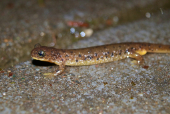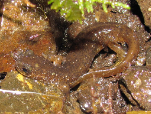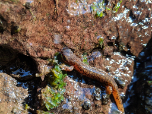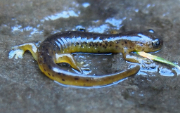Cascade Torrent Salamander (Rhyacotriton cascadae)
Description: A small to medium-sized, semi-aquatic salamander. Dorsal coloration is brown and the underside is bright yellow. Black flecks or spots occur on the back and more densely on the sides. The degree of black spotting or blotching varies with locality, but there seems to be no geographic pattern. The belly sometimes has small grayish flecks. Some populations have a dark stripe on the underside of the tail, posterior to the vent opening. Males have squared, glandular lobes on either side of the vent opening, a trait unique among salamanders. These salamanders have a short, rounded snout and relatively large, prominent eyes. The tail is relatively short, less than the snout to vent length. Females are slightly larger than males. Larvae are of the stream type, with very short gills and a low dorsal tail fin that does not extend onto the back. Coloration is similar to the adult pattern. Hatchling size is about 15.8 mm snout to vent lengt
Habitat: Its natural habitats are temperate forests, rivers, and freshwater springs. It is threatened by habitat loss. These salamanders are typically found under rocks and fallen logs.
Range: It is endemic to the Pacific Northwest in the United States where it is found from Skamania County in Washington south to Lane County in Oregon on the west slope of the Cascade Mountains.
Found in these States:
OR |
WA
Diet: Information on diet of R. cascadae is not available, but adults and juveniles likely feed on a mixture of aquatic and semiaquatic invertebrates.
Reproduction: Courtship and mating occur over most of the year, concentrated in the fall and spring months, based on the presence of spermatophores in the cloacae of females. Females may oviposit at any time of the year, but tend to lay in late spring. In other species of Rhyacotriton, egg deposition sites are in seeps at the heads of springs and this is likely to be similar in R. cascadae. Number of mature ovarian eggs (correlated with clutch size) ranges from 2-13, and average clutch size is eight. In a nest of the closely related species R. kezeri, at least three females may have laid their eggs communally.There is apparently no attendance of the developing eggs. Clutch frequency is once per year. Eggs laid in spring hatch 5-6 months later.
Status: Listed as Near Threatened because its extent of occurrence (EOO) is 27,571 km2, it likely occurs in 10 or fewer threat-defined locations, and there is continuing decline in the extent and quality of its habitat, thus making the species close to qualifying for Vulnerable.
»» Kingdom: Animalia - Animals
»» Phylum: Chordata - Chordates
»» Subphylum: Vertebrata - Vertebrates
»» Class: Amphibia - (Amphibians)
»» Order: Caudata - Salamanders
»» Family: Rhyacotritonidae - Torrent Salamanders
»» Genus: Rhyacotriton
»» Species: Rhyacotriton cascadae - Cascade Torrent Salamander
This article uses material from the Wikipedia article "Cascade Torrent Salamander", which is released under the Creative Commons Attribution-Share-Alike License 3.0. Content may have been omitted from the original, but no content has been changed or extended.
|







